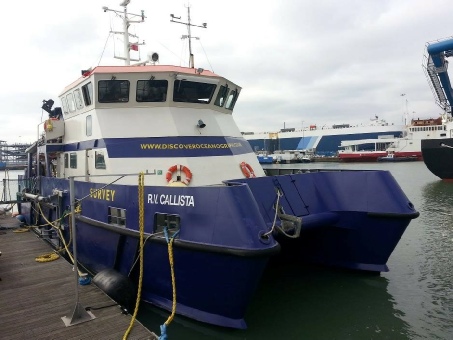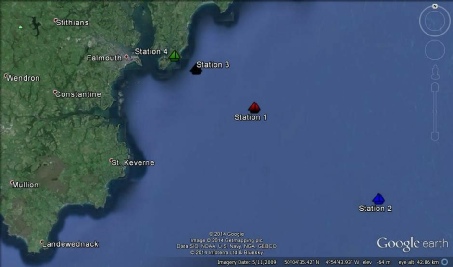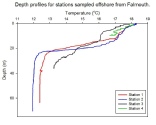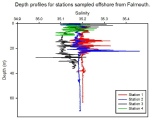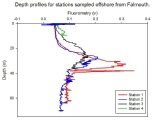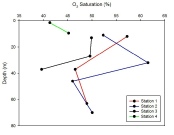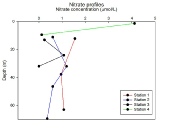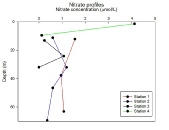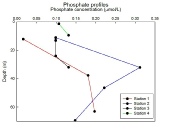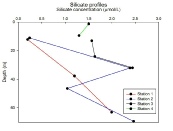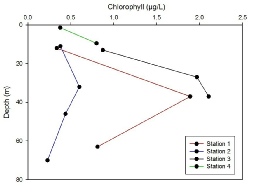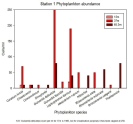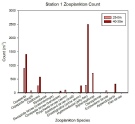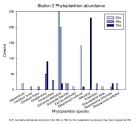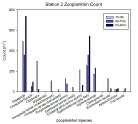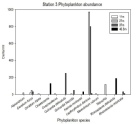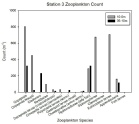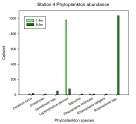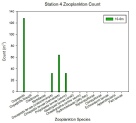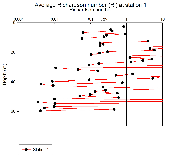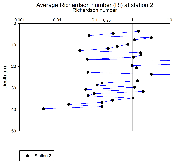
Introduction:
Offshore from Falmouth, the sea is relatively exposed and subject to south-
The aim of the survey was to investigate the features of tidal fronts. Four stations were observed, locations of which are shown in Figure 2. The stations were more stratified offshore, and became more mixed the closer they were to shore. The physical, chemical, and biological structure of each of these stations varied, and are discussed in detail below.
Positions of stations (Figure 1):
Station 1 -
Longitude: 004o 52.17’W
Time: 10.43 UTC
Station 2 -
Longitude: 004o 40.75’W
Time: 13.20 UTC
Station 3 -
Longitude: 004o 57.52’W
Time: 15.48 UTC
Station 4 -
Longitude: 004o 59.51’W
Time: 16.38 UTC
Temperature -
The temperature profiles all show a decrease in temperature with depth.
Station 1 has a steep thermocline at 15-
Station 2 temperature profile has a similar structure to that of Station 1; it has
a steep thermocline at 18-
Station 3 has a multi-
Station 4 is the most inshore profile. It is continuously stratified, with a steady
decrease in temperature from 0-
Salinity -
‘Salinity spiking’ can be seen in Figure 3. This is caused by a mis-
Station 1 has lower salinity in the surface (31.15) and constant salinity of 35.20 from ~5m to the bottom at 65m. The range of the change (0.05) is relatively very small, but may have been caused by freshwater input via rainfall.
Station 2 has relatively constant salinity with depth, and again has slightly lower salinity in the surface which could be due to freshwater input.
Station 3 has higher salinity in the surface (0-
Station 4 has constant salinity of 35.15 throughout the water column. The water column
is well-
Fluorometry -
The fluorometry depth profile shown in Figure 4 indicates where the chlorophyll maxima are in the water column. As a trend, the amount of fluorescence is lowest (0.05 v) from the surface to 20m depth. The fluorescence peaks at a depth around 30 to 40 m. This peak is shown in Station 1, 2, and 3. Station 1 has the highest peak in fluorescence and Stations 2 and 3 have similar values. Station 4 has a different profile: this station was taken in much shallower waters next to the coast line (measurements reach a depth of only 10 m) resulting in lower fluorescence values of 0.1v compared to 0.32v maxima at Station 1.
The chlorophyll appears to accumulate at a depth where the temperature is lower and
below the thermocline. As shown in Figure 2, the thermocline occurs at a depth between
18–20 m. Fluorometry peaks occur just below this depth, this allows the phytoplankton
to utilise the nutrient-
Figure 2: Offshore temperature profile
Figure 4: Offshore fluorometry profile
Station 1 (11:10-
As shown in Figure 5, the velocity changes significantly within the water column.
There is a surface layer of water down to 15m with variable velocity, a band of water
with higher velocity 0.2m/s at around 15-
At Station 1, backscatter has a highest value of around 80 [dB], this layer extends
from 5m to 18m depth (Figure 6).
Station 2 (13:30-
Station 2 was station furthest from the mouth of the estuary. This station shows
higher velocities throughout the water column compared to the others. Between 0–20m
the velocity is highest (0.4m/s), and below 20m it drops to a lower range of 0.175
– 0.350 m/s (Figure 7).
The highest amount of backscatter is seen just below the surface at 5 m, as shown in Figure 8. This trend is clearly shown at Stations 1, 2 and 3, however at Station 2 the backscatter in the deeper water column is higher than 1 and 3.
Station 3 (15:55-
Station 3 was closer to the mouth of the estuary than Station 1 and 2. There is a
sub-
Backscatter (Figure 10) shows a similar trend to the first 2 stations.
Station 4 (16:42-
Station 4 was just outside of the estuary mouth. This also shows a lower and more
constant velocity profile, shown in Figure 11. The velocity is mostly 0.075-
The layer of higher backscatter at this station extends from the surface to 5m depth
(Figure 12), compared to the other stations where the layer was sub-
Velocity
At Stations 1 and 2, the layer of higher velocity located between the surface and
20m is consistent with the depth of the thermocline and changing temperature with
depth. The increased velocity is due to shear between the wind-
Station 3 -
Backscatter
Backscatter indicates where there is a high amount of matter in the water column
that reflects back. This matter can indicate detritus, zooplankton and suspended
sediment. After looking at the zooplankton, it can be seen that the zooplankton vertical
tow from 25-
Phytoplankton are at the base of the ocean food web, and require nutrients, light
and carbon dioxide in order to photosynthesize and grow. The main nutrients (macronutrients)
are nitrate, phosphate, and silicate. Coastal waters are generally eutrophic (nutrient-
During winter months, decreased solar irradiance and increased winds cause the water
column to fully mix. Phytoplankton are light-
Station 1 is stratified with a thermocline at ~12-
Station 2 is stratified with a thermocline between 15 and 23m. There is a chlorophyll maximum below the thermocline at 32m, which is similar to the calculated euphotic zone depth (31.2m). This is coupled with an O2 maximum, which is expected due to the production of O2 during photosynthesis (Figure 20). There is high nitrate (Figure 17), phosphate (Figure 18), and silicate (Figure 19) concentrations at the depth of the chlorophyll maximum, which are likely to be facilitating the bloom. The high chlorophyll concentrations at this depth may be due to an increase in light penetrations through the water column, which could be facilitated by higher solar irradiance, calmer weather, or a decrease in suspended particles.
Station 3 is thermally stratified with a step structure of temperature; it is at a mixing stage in between mixed and stratified, with multiple mixed layers and small temperature gradients. The euphotic zone extends through the whole column (calculated using the CTD as a secchi disk). There is high chlorophyll at 24m and at 32m (Figure 21). Oxygen is high in the surface, which may be due to waves causing mixing, and low at the bottom, which may be due to remineralisation (Figure 20). Phosphate (Figure 18) and silicate (Figure 19) increase with depth, and nitrate is highest at 24m (Figure 17). Nitrate is depleted at the bottom of the water column, which corresponds with the chlorophyll peak. The chlorophyll may therefore be due to old growth, as further phytoplankton growth would be limited by the nitrate.
Station 4 is the most inshore profile, it is 10m deep and is continuously stratified. As at Station 3, the euphotic zone extends through the whole water column. Chlorophyll is highest at the bottom of the water column (10m), which is matched by an increase in O2 (Figure 20). Nitrate (Figure 17) and silicate (Figure 19) are highest in the surface of the water column, which may be due to input via rivers. Phosphate is higher at 10m than at the surface, however (Figure 18). The high chlorophyll at depth, but low nitrate, may show that the chlorophyll maximum at 10m is due to older growth.
The chlorophyll peaks at Stations 1 – 3 are below the thermocline (Figure 4 and 21), which is different to the expected pattern of a peak within the thermocline. This may be due to increased light penetration due to less mixing, or increased solar irradiance. The euphotic zone depths, which were calculated using the secchi disk method, are deep in to the water column.
Figure 17: Offshore nitrate profiles
Figure 18: Offshore phosphate profiles
Figure 19: Offshore silicate profiles
Figure 20: Offshore oxygen profiles
As seen in Figure 21, the chlorophyll levels increase with depth, peaking to a chlorophyll
maximum at depths of around 30 m which decreases again as you move down the water
column, this is shown at Stations 1, 2 and 3. Station 3 has higher the highest Chlorophyll
concentrations, and Station 2 is considerably lower. Station 1 shows as sharp increase
from 0.4 µgrams/L near the surface to a maximum of 1.9 µgrams/L at 37 m. As chlorophyll
concentration acts as an indicator for phytoplankton concentration the pattern shown
helps to support the phytoplankton counts below that suggest higher numbers of phytoplankton
at depth which are similar (around 30 -
Phytoplankton
The overall trend of phytoplankton compositions off shore show low phytoplankton abundance in the surface and shallow waters. For Stations 1, 2, and 3 the amount of phytoplankton increases to its highest at a depth of around 30 – 37 m deep. These stations were in open ocean waters with clearer stratified waters. Here, elevated numbers of phytoplankton are seen just below the thermocline and are also indicated by the high levels of Fluorescence and Oxygen concentrations and lower Nitrate concentrations also at similar depths. Phytoplankton communities are dictated by chemical, physical and biological properties, these include nutrient availability, light levels, predators and grazing, temperature and water column mixing levels.
Leptocylindrus danicus and Guinardia delicatula occur the most through the offshore survey. Station 4 was much shallower, resulting in more constant phytoplankton numbers through the water column. This is because there is not an opportunity for the water column to become stratified like it would in deeper offshore waters where stronger thermoclines and nutriclines can develop. Looking at the Chlorophyll graph (Figure 21), we can see that Station 4 does in fact increase at depth but there is no peak in Chlorophyll, probably because Station 4 was only 10 m deep. There are noticeably higher concentrations of Leptocylindus dancius and Rhizosolenia spp that are just below and equal to 1000 cells/ml for depths of 1.4m and 9.5m (Figure 28). Station 4 is better mixed (shown by Temperature and Salinity profiles), resulting in a high number of the diatom Rhizosolenia spp which are more suited to this kind of environment.
Hydromedusae and Copepoda appear to thrive when Leptocylindrus dancius and Guinardia delicatula are the dominant phytoplankton.
Conclusions from these samples are limited as it only represents a fraction of the entire plankton community. Human error could possibly occurred through personal interpretation during the identification process.
Richardson number
The Richardson number (Ri) is a dimensionless parameter used to estimate the water column stability, and represents the relative importance of static stability and dynamic instability. It compares the relative magnitude between stabilizing forces of the density gradient and the inertial flow forces, and can be calculated using Equation 1.
W here g is gravity (m/s²), H is the water column depth (m), ρ0 is the average density
(kg/m³), δρ is the density change with depth and δu is the horizontal velocity gradient
with depth (m/s) (Knauss, J. 1997).
here g is gravity (m/s²), H is the water column depth (m), ρ0 is the average density
(kg/m³), δρ is the density change with depth and δu is the horizontal velocity gradient
with depth (m/s) (Knauss, J. 1997).
Ri > 1 is the limit from which the flow is described as laminar, where buoyancy forces tend to overcome the inertial forces and stratification of the water column can be found, whereas Ri < 0.25 describes turbulent flows, i.e. the energy provided by the shear flow can be used to overcome the density gradient and vertical mixing as well as shear between the interfaces promoting entrainment can occur in the water column. An intermediate state is found between 0.25 < Ri < 1, where both stratification or mixing is likely to occur.
In Figures 13-
At stations 1, 2, and 3 (Figures 13, 14, and 15) the higher Richardson numbers (Ri
> 1) were correlated with the position of the thermocline, representing the stratification
caused by the temperature gradient and the influence of the buoyancy input near the
surface. Station 2 was located at the tidal front, therefore showing some stability
in the top 10 meters depth as a function of the salinity distribution in addition
with the solar energy input. Also, below the thermocline the lower Ri values (Ri
< 0.25) were correlated with the almost constant temperature distribution indicative
of vertical mixing. Overall, most of the Ri values for station 3 were below the 0.25
limit, showing that turbulent mixing caused by winds and tides overcome the stratification,
except at the thermocline between around 12 and 25 m depth. Station 4 was much shallower
(10.7 m) and consequently more well-
Figure 3: Offshore salinity profile
Offshore data was collected on the vessel RV Callista (pictured above)
Figure 1: Location of Stations 1-
Figure 13: Average Ri number at Station 1
Figure 14: Average Ri number at Station 2
Figure 15: Average Ri number at Station 3
Figure 16: Average Ri number at Station 4
Equation 1
Zooplankton
Zooplankton also bloom at certain depths for each station. However the blooms are notably not at the same depth range as the phytoplankton blooms. Station 1 and 2 (Figure 23 and 25) were the furthest stations offshore and also the deepest. At Station 1, the highest numbers of zooplankton were found between 40 – 30 m, and for Station 2 zooplankton are most abundant between 50 – 40 m.
At both of these stations, Hydromedusae and Copepoda were the most commonly identified
species: at Station 2 there was 750 m^-
Fewer numbers of zooplankton species were found at Station 4 (Figure 29) but at higher
concentrations; Copepoda (130 m^-
Similar compositions of phytoplankton produce similar compositions of zooplankton as different phytoplankton will encourage different predators. Examples of this can be seen in Stations 1 and 2 (Figure 22 and 23, and Figure 24 and 25).
Figure 21: Chlorophyll depth profiles for each station
Figure 22: Station 1 phytoplankton
Figure 23: Station 1 zooplankton
Figure 24: Station 2 phytoplankton
Figure 25: Station 2 zooplankton
Figure 26: Station 3 phytoplankton
Figure 27: Station 3 zooplankton
Figure 28: Station 4 phytoplankton
Figure 29: Station 4 zooplankton
Figure 5: Station 1 Velocity
Figure 7: Station 2 Velocity
Figure 8: Station 2 Backscatter
Figure 9: Station 3 Velocity
Figure 10: Station 3 Backscatter
Figure 11: Station 4 Velocity
Figure 12: Station 4 Backscatter
Figure 5: Station 1 Backscatter
Stratification index
The stratification parameter (ɸ) is another estimation of the degree of stratification of the system as a result of the balance between the tidal currents, which tend to stir the water column, and the energy provided by the buoyancy input in order to maintain any degree of stratification. It represents the work required per unit volume to completely mix the water column. It can be calculated using the equation:
ɸ = log10(H/u³), where H is the average water column and u is the measure of the strength of the tidal currents by using the tidal stream range from the tidal diamond chart near Plymouth.
Values of the stratification parameter higher than 2 (ɸ > 2) indicate strong stratification, whereas complete vertical mixing will be expected if ɸ < 1. The transitions between the two regimes, i.e. the tidal mixing fronts, seem to occur in all cases close to a value of ɸ ≈ 1.5 (Pingree and Griffths, 1978).
As seen on the temperature profiles from the CTD data, all stations showed stratification along the thermocline, with some steep gradients on station 2 and 1, from about 10 to 25 m depth. The higher values for ɸ, different from what should be expected for tidal front regions like Station 2 for instance, are maybe due to the uncertainty and estimation of the tidal currents from the tidal charts. For example, the distance between this station position (50°00’.3 N, 004°40’.8 W) and the tidal stream F position (50°02´.5 N, 004°58´.8 W) used to calculate its tidal current, as well as the difference in the water column depth (Station 2 was 10 meters deeper than the expected water column of tidal stream F) could explain the higher ɸ value for station 2 (ɸ = 3.475), when compared to the values more commonly found on tidal mixing fronts (ɸ ≈ 1.) (Pingree and Griffths, 1978) or to the critical = 2.7 suggested by Simpson and James (1986).
Reference: Simpson, J.H. and James, I.D. (1986). Coastal and estuarine fronts. Baroclinic
Processes on Continental Shelves, 63-
Pingree, R.D. and Griffiths, D.K. (1978). Tidal fronts on shelf seas around the British
Isles. J. Geophys. Res. 83 (C9), 4615-
Simpson, J. and Sharples, J. (2012). Introduction to the Physical and Biological Oceanography of Shelf Seas, , Cambridge University Press, Cambridge, UK
Knauss, J. (1997). Introduction to Physical Oceanography. 2nd edition Prentice-
